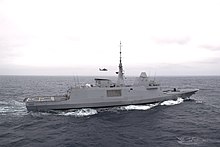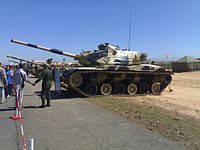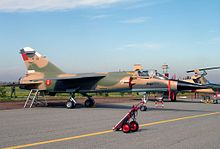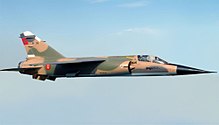| Royal Moroccan Armed Forces | |
|---|---|
| القوات المسلحة الملكية المغربية | |
 | |
| Motto | "الله، الوطن، الملك" "God, Homeland, King" |
| Founded | 1088; 937 years ago (1088) |
| Current form | 1666 |
| Service branches | |
| Headquarters | Rabat |
| Website | tajnid revue |
| Leadership | |
| Supreme Commander | Mohammed VI |
| Minister of Defense | Abdellatif Loudiyi |
| Inspector General | Major-General Mohammed Berrid |
| Personnel | |
| Military age | 18 |
| Conscription | Yes |
| Active personnel | 195,800 |
| Reserve personnel | 150,000 |
| Expenditure | |
| Budget | 119.766 billion MAD $11.796 billion (2023) |
| Percent of GDP | 8.5% (2023) |
| Industry | |
| Foreign suppliers | |
| Related articles | |
| History | Military history of Morocco Ifni War Rif revolt Sand War Six-Day War October War Western Sahara War Gulf War Insurgency in the Maghreb Intervention in Yemen Western Saharan clashes |
| Ranks | Military ranks of Morocco |
The Royal Moroccan Armed Forces (Arabic: القوات المسلحة الملكية المغربية, romanized: Al-Quwwat al-Musallaha al-Malakiyah al-Maghribiyah) are the military forces of the Kingdom of Morocco. They consist of the Army, the Navy, the Air Force, the Royal Gendarmerie, and the Royal Guard.
The Royal Moroccan Armed Forces have experience in counter-insurgency, desert warfare and combined air-land operations. Further experience has come from participating in peace-keeping operations.
History
Main article: Military history of MoroccoThe oldest "Moroccan" military forces are those of the Mauri Berber Kingdoms from around 225 BCE. The Moroccan army has existed continuously since 1088 during the rising of Almoravid Empire in the 11th-century. During the protectorates period (1912–1955), large numbers of Moroccans were recruited for service in the Spahi and Tirailleur regiments of the French Army of Africa (French: Armée d'Afrique). Many served during World War I. During World War II more than 300,000 Moroccan troops (including goumier auxiliaries) served with the Free French forces in North Africa, Italy, France and Austria. The two world conflicts saw Moroccan units earning the nickname of "Todesschwalben" (death swallows) by German soldiers as they showed particular toughness on the battlefield. After the end of World War II, Moroccan troops formed part of the French Far East Expeditionary Corps engaged in the First Indochina War from 1946 to 1954.
The Spanish Army also made extensive use of Moroccan troops recruited in the Spanish Protectorate, during both the Rif War of 1921–26 and the Spanish Civil War of 1936–39. Moroccan Regulares, together with the Spanish Legion, made up Spain's elite Spanish Army of Africa. A para-military gendarmerie, known as the "Mehal-la Jalifianas" and modelled on the French goumieres, was employed within the Spanish Zone.
The Royal Armed Forces were created on 14 May 1956, after the French Protectorate was dissolved in 1955. 14,000 Moroccan personnel from the French Army and 10,000 from the Spanish Armed Forces transferred into the newly formed armed forces, this number was augmented by approximately 5,000 former guerrillas from the "Army of Liberation", About 2,000 French officers and NCOs remained in Morocco on short term contracts until the training programs at the military academies of St-Cyr, Toledo and Dar al Bayda produced sufficient numbers of Moroccan commissioned officers. Four years later, the Royal Moroccan Navy was established in 1960.
The Moroccan military's first engagement as an independent country in the 20th century was the Ifni War, followed by the Rif revolt, and then the border war of 1963 with Algeria, In the early 1960s, Moroccan troops were sent to the Congo as part of the first multifunctional UN peacekeeping operation ONUC, The Royal Moroccan Armed Forces fought on the Golan front during the Yom Kippur War of 1973 (mostly in the battle for Quneitra) and intervened decisively in the 1977 conflict known as Shaba I to save Zaire's regime. After Shaba II, Morocco was part of the Inter-African Force deployed on the Zaire border, contributing about 1,500 troops. The Royal Moroccan Armed Forces also took a symbolic part in the Gulf War among other Arab armies.
Between 1975 and 1991, the Moroccan Armed Forces fought a 16-year war against the POLISARIO, an Algerian backed rebel national liberation movement seeking the independence of Western Sahara from Morocco. From the mid-1980s on, Morocco largely managed to keep POLISARIO troops at bay by building a huge sand wall, staffed by an army roughly the same size as the entire Sahrawi population, enclosing the Southern Provinces within it. The enclosure contained most of the economically useful parts of Western Sahara, including Bou Craa, El-Aaiun, and Smara. The Moroccan army destroyed all the posts created by the Polisario and won decisively the majority of battles, but artillery strikes and sniping attacks by the guerrillas continued, and Morocco was economically and politically strained by the war.
In the 1990s, Moroccan troops went to Angola with the three UN Angola Verifications Missions, UNAVEM I, UNAVEM II, and UNAVEM III. They were also in Somalia, with UNOSOM I, the U.S.-led Unified Task Force (UNITAF), known by its U.S. codename of 'Restore Hope' and the follow-on UNOSOM II, They saw fighting during the Battle of Mogadishu to rescue a U.S. anti-militia assault force. Other peace support involvement during the 1990s included United Nations Transitional Authority in Cambodia (UNTAC) in Cambodia, and the missions in the former Yugoslavia: IFOR, SFOR, and KFOR.
On 14 July 1999, the Moroccan Armed Forces took part in the Bastille Day parade on the Champs-Élysées, which was exceptional for a non-French armed forces, at the invitation of then French President Jacques Chirac.
Branches



The modern Moroccan military is composed of the following branches:
The Royal Army
Main article: Royal Moroccan ArmyThe Royal Moroccan Army is the branch of the Royal Moroccan Armed Forces responsible for land-based military operations. The army is about 175,000 troops strong, In case of war or a state of siege, an additional force of 150,000 Reservists and paramilitary forces, including 20,000 regulars of the Royal Moroccan Gendarmerie and 30,000 Auxiliary Forces come under the Ministry of Defense command. The Moroccan Army helped with the annexation of Western Sahara which is disputed.
Royal Guard
Main article: Moroccan Royal GuardThe Moroccan Royal Guard is officially part of the Royal Moroccan Army, However, it is under the direct operational control of the Royal Military Household of His Majesty the King, The sole duty of the guard is to provide for the security and safety of the King and royal family of Morocco with 1,500 personnel.
The Royal Air Force
Main article: Royal Moroccan Air ForceThe Royal Moroccan Air Force is the air force branch of the Moroccan Armed Forces, It employs 13,000 personnel and is equipped with more than 300 aircraft. In the 21st century, the Royal Moroccan Air Force started a progressive modernization program of its aging fleet and its technical and operational capacities.
The Royal Navy
Main article: Royal Moroccan NavyThe Royal Navy is the branch of the Moroccan Armed Forces responsible of conducting naval operations, 7,800 personnel strong Its mission includes the protection of Moroccan territory and sovereignty, as well as the control of Morocco's 280,000-square-kilometre (81,000 sq nmi) Exclusive Economic Zone. Given Morocco's significant coastline (2,952 km) and strategic position overseeing the strait of Gibraltar, it (with Spain and the United Kingdom) is deeply involved in the security of this important international waterway.
Royal Gendarmerie
Main article: Royal Moroccan GendarmerieThe Moroccan Royal Gendarmerie is the Gendarmerie body of Morocco. The legislation which founded the Royal Moroccan Gendarmerie describes it as a public force designed to guarantee public security and public order and the implementation of laws. This legislation text attaches the Gendarmerie to the Royal Moroccan Army, then constituting a military force in its structure, administration and command forms. It consists of officers and NCOs.
History of participation in peacekeeping operations

Congo 1960–1961
Congo United Nations Operation in the Congo
By 20 July 1960 Morocco had deployed 1,250 troops in Congo.
Somalia 1992–1994
Somalia UNOSOM I, UNITAF, UNOSOM II
Bosnia and Herzegovina 1996–2007
Bosnia and Herzegovina IFOR, SFOR, EUFOR Althea
Kosovo 1998-1999
Kosovo Kosovo War
Main article: Kosovo ForceMorocco has deployed one company of soldiers to contribute in the NATO-led international peacekeeping force which was responsible for establishing a secure environment in Kosovo.
Haiti 2004–2006
Haiti MINUSTAH
In 2004, Morocco provided an infantry company as part of a joint Spanish-Moroccan battalion, which was deployed in Fort Liberté, in the north-eastern part of Haiti. Disagreements between the United Nations and the Spanish government led to Spain´s withdrawal from the mission, leaving the Moroccans in charge of a much larger area than what was initially designed. The last Moroccan troops left Haiti in 2006, and the area was covered by a battalion from Uruguay, which already had another unit in the South of the country. About six Moroccan Army officers served in the mission HQ during this period.
Democratic Republic of the Congo since 1999
Main article: MONUSCOMorocco has deployed 6 observers, one mechanised infantry battalion and one field hospital to participate in the United Nations Security Council efforts to monitor the peace process of the Second Congo War.
Ivory Coast since 2004
Ivory Coast UNOCI
Main article: United Nations Operation in Côte d'IvoireMorocco has deployed one infantry battalion to participate in the UNOCI peacekeeping mission whose objective is "to facilitate the implementation by the Ivorian parties of the peace agreement signed by them in January 2003" (which aimed to end the Ivorian Civil War). The two main Ivorian parties here are the Ivorian Government forces who control the south of the country, and the New Forces (former rebels), who control the north. The UNOCI mission aims to control a "zone of confidence" across the centre of the country separating the two parties.
Central African Republic since 2013
Central African Republic BINUCA, MINUSCA
Main article: EUFOR RCAThe Moroccan Royal Armed Forces has sent a contingent of 777 Moroccan soldiers on December 25, 2013 for the Central African Republic to be deployed in the UN Integrated Peace building Office (BINUCA). Moroccan authorities also said they stand ready to support the Central African Republic in its path toward peace and stability.
Motto
The Royal Moroccan Armed Forces motto, which graces every military base, banner, and ship, is: God, The Homeland, and The King.
- God: The Creator of all destiny, by His Mercy we draw from, He ordains our choice to the right path.
- The Homeland: The Land that begets our bounty, from which we sustain ourselves we protect its integrity and defend it from all enemies.
- King: Our commander and guide, he guides our renaissance and development, protector of our people's rights.
Gallery
-
 RMA's M109A5 howitzer.
RMA's M109A5 howitzer.
-
 Moroccan M60A3 during a 2006 Army expo.
Moroccan M60A3 during a 2006 Army expo.
-
 TATA Kestrel to be manufactured in Morocco as part of modernization of Army.
TATA Kestrel to be manufactured in Morocco as part of modernization of Army.
-
 US Marines and Moroccan soldiers during exercise African Lion in Tan tan.
US Marines and Moroccan soldiers during exercise African Lion in Tan tan.
-
 Royal Moroccan Air Force Mirage F1.
Royal Moroccan Air Force Mirage F1.
-
Floréal Class Mohammed V.
-
 Royal Moroccan Air Force SA330 Puma.
Royal Moroccan Air Force SA330 Puma.
-
 Moroccan FREMM frigate
Moroccan FREMM frigate
-
 Moroccan SF Polaris MRZR-2/4
Moroccan SF Polaris MRZR-2/4
-
 Moroccan soldier using the Mk19 grenade launcher
Moroccan soldier using the Mk19 grenade launcher
-
 Moroccan M-SOF operator training Mauritanian forces
Moroccan M-SOF operator training Mauritanian forces
-
 Moroccan Mirage F-1 in flight
Moroccan Mirage F-1 in flight
-
Royal Moroccan Air Force F-16 at the 2012 Marrakech Air Show
References
- "La Garde royale marocaine". www.maghreb-observateur.qc.ca.
- Fitch, Chris (26 October 2018). "Reintroduction of military conscription in Morocco". Geographical. Retrieved 22 November 2018.
- ^ International Institute for Strategic Studies (14 February 2022). The Military Balance 2022. London: Routledge. p. 359. ISBN 978-1032279008.
- Dahir n° 1-22-75 of 18 Jumada I 1444 (December 13, 2022) promulgating the finance law No. 50-22 for the 2023 budget year.
- "Morocco - gross domestic product (GDP) 1988-2028".
- Kasraoui, Safaa (16 March 2021). "Morocco Among 40 Largest Importers of Major Arms Worldwide". Morocco World News. Retrieved 12 November 2022.
- IISS 2013, pp. 394
- Livy Ab Urbe Condita Libri 29.30
- "Africa :: Morocco — The World Factbook - Central Intelligence Agency". www.cia.gov. 14 November 2022.
- "57e anniversaire de la création des FAR". 2014-05-16. Archived from the original on 2014-10-06. Retrieved 2014-10-03.
- Ifni & After, Time Magazine, December 16, 1957
- Algerian-Moroccan War 1963 – onwar.com
- C. Kohn, George. Dictionary of Wars. p. 10.
- "National Intelligence Daily (Cable) : 5 June 1978" (PDF).
- "National Intelligence Daily (Cable), 27 novembre 1978" (PDF).
- Berman, Eric G.; Sams, Katie E. (2000). Peacekeeping In Africa: Capabilities And Culpabilities. Geneva: United Nations Institute for Disarmament Research. pp. 219–220. ISBN 92-9045-133-5.
- The Sahara War 1975–1991 – onwar.com
- "Web Page Of Facts About The Western Sahara Including Landuse, Health, Population, Economy And Human Rights". New Internationalist. December 5, 1997.
- "United Nations Operation in Somalia I: facts and figures".
- Le 14 juillet 1999, les Forces armées royales ont défilé sur les Champs-Élysées.
- ^ IISS 2013, pp. 396
- The Military Balance 2023, page 442
- "UN Secretary General Grateful to Morocco for Action for Stability in Central African Republic". www.moroccanembassy.sa.
- "Constitution of Morocco, 1992".
- "Morocco and Tata Advanced Systems Sign Landmark Defence Manufacturing Deal". Financialexpress. 2024-09-30. Retrieved 2024-10-03.
Bibliography
- International Institute for Strategic Studies (February 2021). "The Military Balance, Volume 121, Issue 1 (2021)". The Military Balance. 121 (1). London: Routledge. ISSN 0459-7222.
See also
- Auxiliary Forces a paramilitary force composed of army veterans which, following the command of the Ministry of the Interior, supplements the military, Gendarmerie and police when needed.
- Battle of Smara (1979)
| Morocco articles | ||||||||||||
|---|---|---|---|---|---|---|---|---|---|---|---|---|
| History |
|  | ||||||||||
| Geography | ||||||||||||
| Politics | ||||||||||||
| Economy | ||||||||||||
| Culture |
| |||||||||||
| Militaries of the Arab world | |
|---|---|
| Sovereign states | |
| States with limited recognition | |
| Autonomous regional armed forces | |
| Non-state actors | |
| italic - country that sometimes recognized as part of Arab world | |
| Leadership |
| ||||||||||||||
|---|---|---|---|---|---|---|---|---|---|---|---|---|---|---|---|
| Branches |
| ||||||||||||||
| Former commanders | |||||||||||||||
| Operations and history | |||||||||||||||
| Equipment |
| ||||||||||||||
| Moroccan security forces | |
|---|---|
| Military | |
| Law enforcement | |
| Intelligence | |